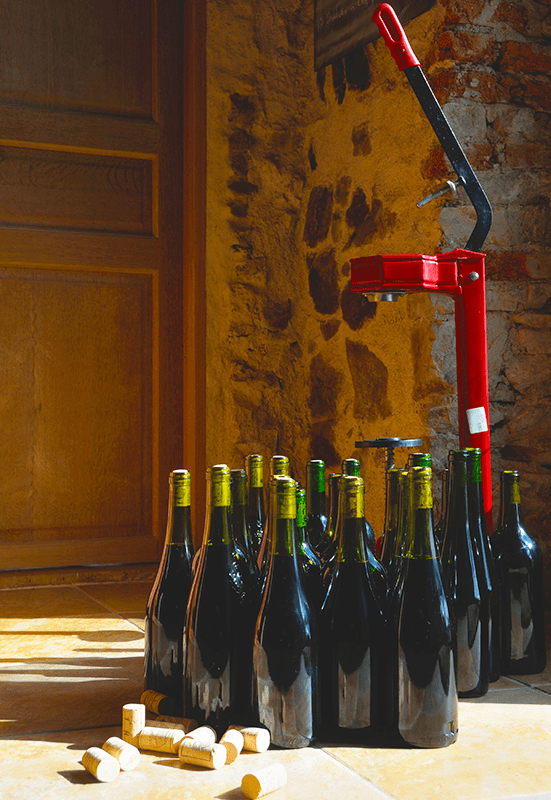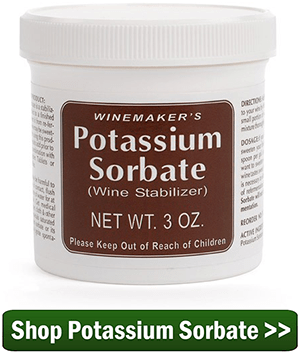 I made an apple cider and a apple/blueberry cider. Both are in the aging process (4 months before bottling). I have the apple cider in a 5 gal. oak keg and the blueberry on in a 5 gal. carboy. Should I be adding sulfites before bottling the wine?
I made an apple cider and a apple/blueberry cider. Both are in the aging process (4 months before bottling). I have the apple cider in a 5 gal. oak keg and the blueberry on in a 5 gal. carboy. Should I be adding sulfites before bottling the wine?
Name: Mike in NY
State: NY
—–
Hello Mike,
If you are aging your wine in bulk, such as a carboy or oak wine barrel, we recommend treating the wine with potassium metabisulfite before the aging. So hopefully you’ve already treated it with some form of sulfite. This is to keep oxidation and spoilage down while in the bulk aging vessel.
Regardless if you have or not, we also recommend adding sulfites before bottling. This dose is to keep the oxidation and spoilage down while the wine is in the wine bottle. Sulfites want to leave as SO2 gas over time and during rackings, so it does need to be replenished at various stages. Here is more information about when to add sulfites to a wine.
Also at bottling time, you may also want to add potassium sorbate. This will also help to stop any type of organism from multiplying and spoiling your cider. Potassium  sorbate is mandatory if you plan or sweetening back your cider before bottling, or there are still sugars in the wine leftover from the fermentation. Not adding it in these situations could result in a re-fermentation in the wine bottle. This would lead to either popping wine corks, or worse yet, exploding wine bottles.
sorbate is mandatory if you plan or sweetening back your cider before bottling, or there are still sugars in the wine leftover from the fermentation. Not adding it in these situations could result in a re-fermentation in the wine bottle. This would lead to either popping wine corks, or worse yet, exploding wine bottles.
Since your are making apple wine/cider I will also mention this: we also recommend adding ascorbic acid to help battle the oxidation issue when using apple juice. Apple juice/wine likes to turn brown very easy. Ascorbic acid will help to slow down the process and keep your cider looking pretty. The optimal time to add this is right before fermentation, but right now is better than never.
If you’d like to read a little more on this subject, you may want to take a look at Adding Campden Tablets To Homemade Wine. This is another post on this blog.
 Adding sulfites before bottling is arguably the most import addition. It is the last time you will be able to do anything directly to the wine to keep it, so don’t skip it.
Adding sulfites before bottling is arguably the most import addition. It is the last time you will be able to do anything directly to the wine to keep it, so don’t skip it.
Happy Winemaking,
Ed Kraus
—–
Ed Kraus is a 3rd generation home brewer/winemaker and has been an owner of E. C. Kraus since 1999. He has been helping individuals make better wine and beer for over 25 years.

Ed, how much ascorbic acid should be used per gal with apple wines ?
Thanks, Ron
Ron, it doesn’t take much. For each gallon add 1/8 teaspoon of ascorbic acid to your wine:
Ascorbic Acid
http://www.eckraus.com/2-oz-ascorbic-acid.html
I processed a carboy of Scuppernong wine in Oct. It was slow to ferment so I added Yeast nutrient. It finished about 1st. of November and I racked it several times and have a perfectly clear and beatiful wine. When I tasted it had a sulphur taste and smell. I called and talked to one of your reps. and she advised me to add 11/2 tsp. of Pot Meta. It has set for about 3 months and has improved some but still has the off taste and smell. Can I do anything to salvage this corboy or should I write up to a bad experience. Charles
Hello Charles,
Sorry you having such an issue with the Scuppernong. There are two further steps you can take: The first is to rack the wine back-and-forth, from one container to the next, a couple of times. Do this in a splashing manner. In other words, hold the siphon hose. Aim it onto the side wall of the fermenter, etc. The second thing would be to get a degassing/mixing paddle. This actually chucks onto a hand drill, and spins quickly into the wine to agitate it and cause the gases to escape. With either of these methods it is important that you treat the wine with potassium metabisulfite, again, to drive out any oxygen introduced into the wine with either of these processes.
Degassing/Mixing Paddle
http://www.eckraus.com/de-gassing-mixing-paddle.html
My Fruits wine has ph4. What should be normal ,and if not could something be done about it?
Hello William, you want your pH to be between 3.6 and 3.4. Remember that the scale works backwards with acidity, so your reading of 4.0 means that your acidity is too low. You can add Acid Blend to the wine to increase the acid level and lower the pH, but I would do it too taste as well. I would also add it to a measured sample of the wine, like a gallon, to establish a dosage, first. That way if you add too much you can blend the sample back and start all over with a new sample.
Since your are making apple wine/cider I will also mention this: we also recommend adding – See more at: http://www.eckraus.com/blog/adding-sulfites-bottling-time#sthash.HFgGAgTo.dpuf
I have made a lot of wine and love doing so. My question is, Would there be any issues with using beer bottles to bottle my wine?
Bill, you can use beer bottles to bottle your wine. However, there are a couple of things to consider. The following article will discuss this in more detail.
Can I Bottle My Wine In Beer Bottles
http://www.eckraus.com/blog/can-i-bottle-my-wine-in-beer-bottles
I was wondering – if I rinse my bottles with Postassium Metabisulfite just before bottling would the residual water/solution left in the bottle be enough to stabilize my wine as I bottle it instead of adding 1/4 tsp. to my 6 gallon carboy before bottling? If not, then should I not use the solution to rinse my bottles if I have added it to the wine already?
Patricia, if you use a sulfite solution to sanitize your bottles, you still need to add sulfites directly in the wine at bottling time. You can still use the sulfites to sanitize the bottles.
I hear from people that putting sulftes in your wine gives people headaches